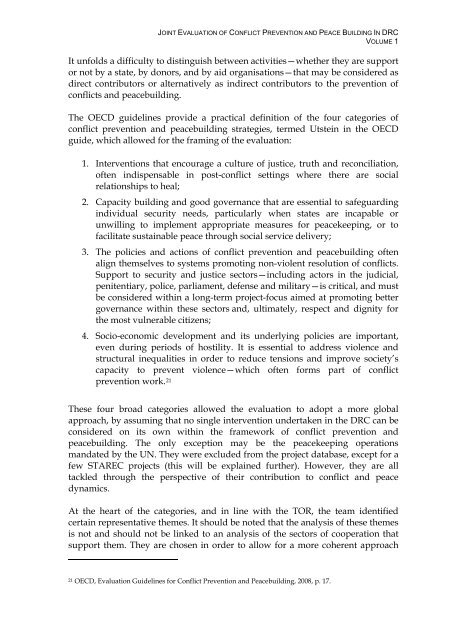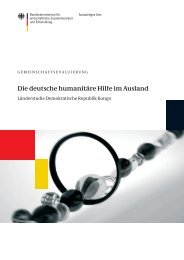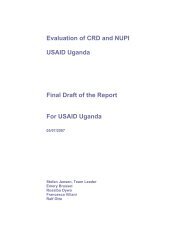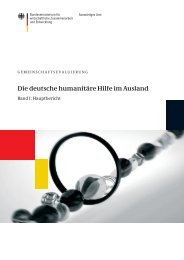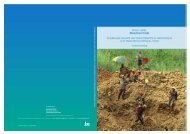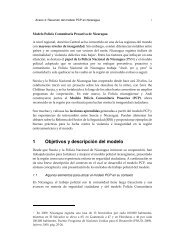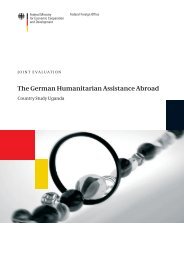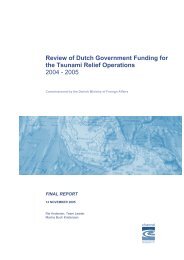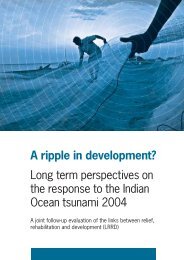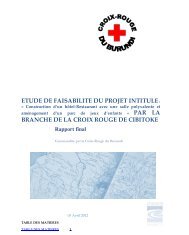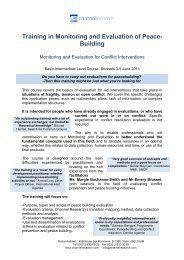Amani Labda - Peace Maybe Joint Evaluation of Conflict - Channel ...
Amani Labda - Peace Maybe Joint Evaluation of Conflict - Channel ...
Amani Labda - Peace Maybe Joint Evaluation of Conflict - Channel ...
Create successful ePaper yourself
Turn your PDF publications into a flip-book with our unique Google optimized e-Paper software.
JOINT EVALUATION OF CONFLICT PREVENTION AND PEACE BUILDING IN DRCVOLUME 1It unfolds a difficulty to distinguish between activities—whether they are supportor not by a state, by donors, and by aid organisations—that may be considered asdirect contributors or alternatively as indirect contributors to the prevention <strong>of</strong>conflicts and peacebuilding.The OECD guidelines provide a practical definition <strong>of</strong> the four categories <strong>of</strong>conflict prevention and peacebuilding strategies, termed Utstein in the OECDguide, which allowed for the framing <strong>of</strong> the evaluation:1. Interventions that encourage a culture <strong>of</strong> justice, truth and reconciliation,<strong>of</strong>ten indispensable in post-conflict settings where there are socialrelationships to heal;2. Capacity building and good governance that are essential to safeguardingindividual security needs, particularly when states are incapable orunwilling to implement appropriate measures for peacekeeping, or t<strong>of</strong>acilitate sustainable peace through social service delivery;3. The policies and actions <strong>of</strong> conflict prevention and peacebuilding <strong>of</strong>tenalign themselves to systems promoting non-violent resolution <strong>of</strong> conflicts.Support to security and justice sectors—including actors in the judicial,penitentiary, police, parliament, defense and military—is critical, and mustbe considered within a long-term project-focus aimed at promoting bettergovernance within these sectors and, ultimately, respect and dignity forthe most vulnerable citizens;4. Socio-economic development and its underlying policies are important,even during periods <strong>of</strong> hostility. It is essential to address violence andstructural inequalities in order to reduce tensions and improve society’scapacity to prevent violence—which <strong>of</strong>ten forms part <strong>of</strong> conflictprevention work. 21These four broad categories allowed the evaluation to adopt a more globalapproach, by assuming that no single intervention undertaken in the DRC can beconsidered on its own within the framework <strong>of</strong> conflict prevention andpeacebuilding. The only exception may be the peacekeeping operationsmandated by the UN. They were excluded from the project database, except for afew STAREC projects (this will be explained further). However, they are alltackled through the perspective <strong>of</strong> their contribution to conflict and peacedynamics.At the heart <strong>of</strong> the categories, and in line with the TOR, the team identifiedcertain representative themes. It should be noted that the analysis <strong>of</strong> these themesis not and should not be linked to an analysis <strong>of</strong> the sectors <strong>of</strong> cooperation thatsupport them. They are chosen in order to allow for a more coherent approach21 OECD, <strong>Evaluation</strong> Guidelines for <strong>Conflict</strong> Prevention and <strong>Peace</strong>building, 2008, p. 17.


